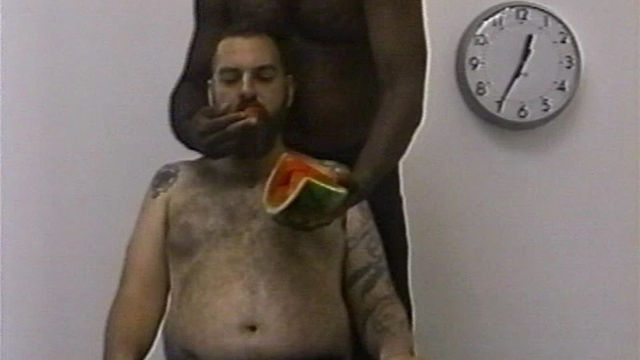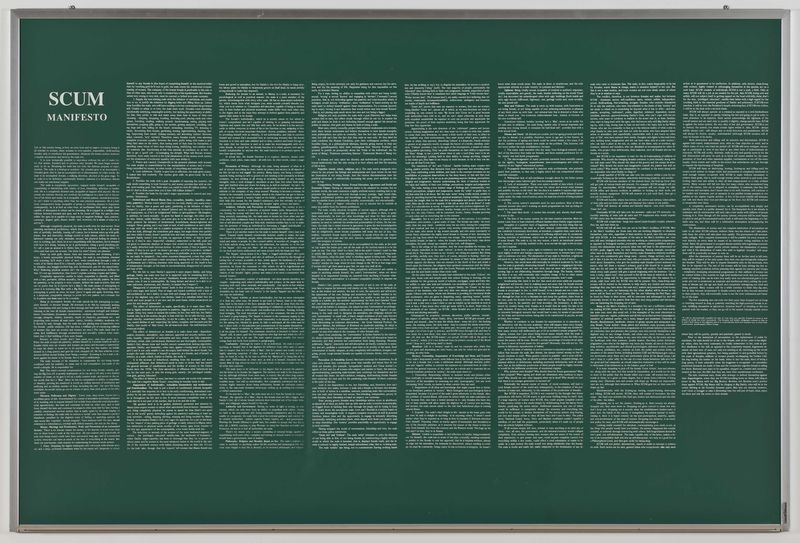
Nayland Blake
Nayland Blake is known for his provocative videos, performances, and sculptures that examine queer sexuality, erotic deviance, and cultural margins. He explains: "I don't really see the work as a vehicle for expressing an idea about my sexuality. I see it as another form of practicing my sexuality."# There is evidence of such practice in Dual Restraint (1990), a large straitjacket designed to accommodate two bodies, which hangs slack on the wall. Its sagging form suggests wear and tear, and its empty compartments make room for psychic projection, encouraging viewers to imagine themselves or someone else occupying the uninhabited spaces. It is not an entirely unwelcome proposal: even though Dual Restraint mimics a disciplinary garment, intended for physical control, it also conveys elective intimacy—that two people might choose to be in such a profoundly confined space together. In this combined allusion to affection and discipline, Dual Restraint underscores the deep ambivalences and dualities that Blake's work often unearths and amplifies.
A similarly nuanced scene exists in Gorge (1998), a single-channel video in which the naked, rounded torsos of two men fill most of the frame. One figure—Blake himself—sits centrally while the other stands off to the side, in the frame only from the neck down. For the duration of the video, this man feeds Blake a variety of iconic American foods (a slice of pizza, an enormous sandwich, watermelon) while a loop of the song "Bunny Hop" (associated with a 1950s novelty dance) plays in the background (the bunny is a recurring motif—a sort of alter ego—in Blake's practice). When Blake made Gorge, he and his collaborator were part of a fetish scene referred to as "gaining and encouraging," which focuses on eating, gaining weight, and encouraging weight gain in others. At first glance the scene seems more madcap than erotic, the kind of physical comedy situation one might expect from Charlie Chaplin. But it quickly moves from humorous to acutely visceral, and it is made clear that Blake willingly confronts nuanced and oscillating moods: from arch sensuality—gnawing erotically at whatever is put before him—to insatiable gluttony, to a determined physical endurance (he often appears to be on the verge of being sick but doesn't waver in his consumption).
The men's relationship remains opaque too—not least because of their apparent racial difference (Blake looks white while his captor/paramour is black). Indeed, Blake has cited Edouard Manet's Olympia (1863), with its master-slave narrative, as a source for Gorge's imagery.# In fact, Blake is of biracial heritage—the experience of which is another motif that runs through his work—but barring this knowledge, the other man's actions undermine any direct correspondence to Olympia's racially inscribed power dynamics. He shifts from tender (gently wiping spills from Blake's body) to domineering (forcing Blake to eat) to submissive (at times seeming trapped by the parameters of the performance). What initially appears to be a strange and regimented ritual spills into more complicated terrain, fraught with shifting relations of power and themes of race, size, sex, and consumption. From a wider angle still, the video functions as an inquiry into desire in America, where libidinal urges are often sublimated into or tied up with appetite.

Eating remains central in Blake's Feeder 2 (1998)—a one-room cottage with two windows and a small door built of gingerbread tiles on a steel frame. Appetite is titillated by the scent of gingerbread, which fills the gallery space. Over time, the potency of this smell threatens to stifle, if not nauseate, the viewer. As in a fairy tale, sweetness is used to seduce, to lure bodies into a space, but here, as in Hansel and Gretel, the dark and cloistered house could just as easily be rendered a trap. Like Gorge, Feeder 2 conveys a sense of heft and something ravenous, off-kilter, and vaguely allegorical. And as in Dual Restraint, there is a sense of past action and absent bodies, of intensely intimate relations that vacillate between seduction and control, release and entrapment.
—Leora Morinis


